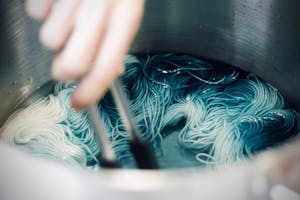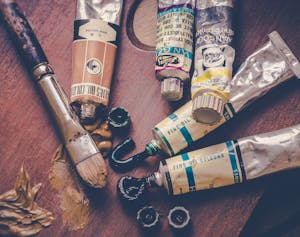Traditionally, screen printing was always performed on 100% cotton materials. Because it’s both easier and cheaper for this particular process. However, as the market for printing on 50% cotton and 50% polyester has grown. It’s time to push the boundaries and try to perfect screen printing on 50/50 blends. At A.I.R. Conway, we make it our business to stay ahead of the trends. Read on to find out more about the process we’ve developed that makes attractive, accurate Screen Printing on 50/50 blends a reality.
Why Not Just Screen Print Like Normal?

Due to its composition, a 50/50 fabric blend is highly susceptible to bleeding. The process of screen printing on a 50/50 blend involves heating the fabric that is going to be printed on, which can cause a 50/50 fabric blend’s dye to start to transition to a gas, which in turn causes the fabric dye to mix with the ink. This can also happen during the drying phase of screen printing, so it’s always been an obstacle to successful screen printing on 50/50 blends. As technology has advanced, there are now more accurate ways to monitor the temperature of the ink and the temperature of the 50/50 blend dyes in order to prevent this messy and unacceptable outcome.
Another factor in dealing with screen printing on 50/50 blends is that it requires a different type of dye from those required to screen print on 100% cotton shirts. These inks must be highly resistant to bleeding due to the susceptibility of bleeding from the fabric’s dye. As the market for 50/50 blends has increased, more screen printing companies are able to invest in these dyes, giving customers a wider choice of fabrics.
Successful Screen Printing on 50/50 Blends

While screen printing on 50/50 blends is possible, there is significant expertise required to ensure that the final product will look great. The first thing to pay attention to is the temperature of the fabric during processing. While the ink needs to be heated up to at least 320 degrees Fahrenheit, the 50/50 blend fabric can’t surpass 360 degrees Fahrenheit before bleeding will occur. Keeping ink film thickness as low as possible is vital, as it’s more difficult to control the temperature of the ink the thicker it is.
Quality screen printing on 50/50 blends requires high screen tension. While this is helpful for screen printing on any fabric, it’s incredibly important when it comes to screen printing on 50/50 blends. High screen tension produces low off-contact (the space between the fabric and the screen), which is exactly what you need in order to get a good result on 50/50 blends. High screen tension also lets you print with less ink, allowing for a thin ink film which creates a better product per the above.
The last important step that creates a beautiful screen print on a 50/50 fabric is the curing process, which ensures that the ink stays on the fabric it’s been printed on. There are four standard ways to determine whether the cure of a print is correct, and one is better than the others. The first and most common way to check the cure is with heat-tape strips. However, these strips don’t give an exact measurement of temperature, so they don’t work very well for something as precise as screen printing on 50/50 blends.
The second way is by using a pyrometer that reads the temperature without touching the ink. However, this reading only reflects the temperature of the ink, not the fabric dye, and you need to see both for the best results. The third way is with a digital ink probe, but that process poses the same problem as the pyrometer. While all of these are fast ways to ensure that printing is done correctly on other fabrics, the only real way to test 50/50 blends is through washing the fabric and seeing how the print held up. This process is slower and more expensive than other options, but it’s a necessity for screen printing on 50/50 blends.
When is Screen Printing on 50/50 Blend Not Ideal?

While screen printing on 50/50 fabrics is possible, some colors are easier to capture than others. There are certain colors that are difficult to work with even on 100% cotton fabrics, such as purple, kelly green, royal blue, and turquoise. On a 50/50 blend, they will not appear true to the intended color. It’s also difficult to create an exact pantone color on a 50/50 blend. If you require strong jewel tones or a precise color match, a 100% cotton fabric will work better.
Contact A.I.R. Conway for All Your Screen Printing Needs!
We at A.I.R. Conway are happy to answer any questions you have concerning screen printing on 50/50 blends—or any other screen printing needs you may have. We’ve been in the business since 1988, and we’d be glad to help you make the best printing decision for your needs. Our proprietary process for screen printing on cotton/polyester blends utilizes all of the cutting-edge best practices and creates a fantastic result. We also do digital printing and embroidery, and we can walk you through making the best choices for your order.
Screen printing on 50/50 blends should only be done by the best, so contact us today with any questions you may have or to place a printing order for your own 50/50 blend fabric today!
